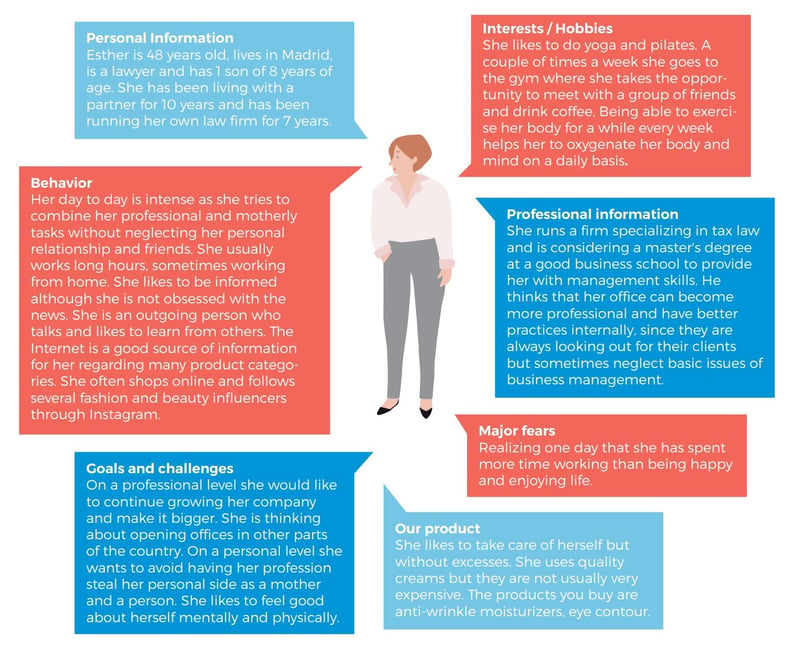Would you like to create relevant content and campaigns for each of your customers and generate more engagement? Defining your Buyer Personas is the first step!

The creation of Buyer Personas is one of the most used methods in digital marketing, especially in Inbound Marketing, a marketing approach that consists of creating relevant content and campaigns that respond to the interests and concerns of our customers to attract them by providing value.
This approach is closely linked to customer-centricity, as it consists of capturing the customer's attention by talking about the issues that interest them, rather than talking about our brand. As we have already announced on numerous occasions, companies are increasingly moving towards customer intelligence strategies in which talking about the benefits of our products or services is no longer effective. On the contrary, organizations are now creating content that brings value to their target market.
In this article we show you how to take a step further towards customer-centric marketing strategies by creating your Buyer Persona.
If you already know what a Buyer Persona is and how to create it, you can directly download our free template to create your Buyer Personas:
What Is a Buyer Persona?
A Buyer Persona is nothing more than a representation of our ideal customer. In other words, each Buyer Persona represents one of the types of clients we have. Thus, it is common for companies to have between 2 and 8 Buyer Personas depending on the diversification of their customer portfolio.
What Do You Need to Create a Buyer Persona?
As said in the video, Buyer Personas are created from the information we already have about our existing customers. In this sense, customer data plays a fundamental role in the creation of the archetype.
It is important to note that creating Buyer Personas is not like other types of customer segmentation. The main characteristic of this method is that it aims to build a realistic and human-like version of the customer. In this sense, in order to define our Buyer Personas, in addition to demographic data, we need personal information about our customers: interests, hobbies, concerns, dreams, fears, professional challenges, family situation, etc. The more we manage to humanize the profile, the better results we will get.
In this sense, it may be interesting to carry out other customer knowledge processes before creating our Buyer Personas. Customer segmentation or market research can be very useful to define more holistic and reliable archetypes.
On the other hand, pain points must be explored when creating a Buyer Persona. The objective of this process is to identify our clients' pain points —their needs— so that we can solve them. Therefore, identifying our customer's pain points is crucial and one of the elements that will help us distinguish between types of clients.
If we identify the needs of our target customers, we are automatically identifying their motivations and what drives them to make a purchase, to look for information about a product or to follow a brand on a social media, for example.
Consolidating an exhaustive and complete vision of who our ideal customers are and what they need will help us to define much more efficient customer, marketing and sales strategies. In addition, our Buyer Personas can also help us define our brand image, our content strategy, our marketing campaigns and our customer experience.
Buyer Persona: Customer Journey and Conversion Funnel
The creation of a Buyer Persona has much to do with the customer journey and the purchase or conversion funnel.
The customer journey is the process our clients go through from the moment they discover our brand until they end the relationship with our company. The conversion funnel refers to the stages the customer goes through during this journey:

When creating our Buyer Personas it is essential that we look at both the aspects that drive the customer along the conversion funnel and the barriers that hold them back and prevent them from moving to the next stage.
Therefore, the creation of Buyer Personas is a process linked to the definition of the customer journey and should explore at what stage of the conversion funnel they are and why. The goal is to identify the drivers that will move clients to the next stage.
How to create a Buyer Persona? Steps + Template
Here are the steps you should follow to create your Buyer Personas.
If you prefer, you can download here our Buyer Persona template:
1. Establish what information and data you need
Al businesses are different and, of course, every company has different objectives. In this sense, depending on what we want to achieve, we will prioritize one type of information or another when creating our profiles.
Therefore, the first step to create our Buyer Personas is to establish our business objectives —what we want to achieve— and the questions —what we need to know to meet these objectives—.
2. Explore what information you already have and what data you are missing
Once we know what we want to achieve and what information we need, it is essential to check whether we have this information or whether, on the contrary, we need to collect more customer data.
3. Research and information gathering techniques
It is very likely that we do not have all the information we need to answer all our questions. That is why we should define a roadmap of the actions we must carry out to collect the missing data.
Most times, the extra information we need can be easily obtained by conducting surveys or interviews with our existing customers or by applying other market research techniques. Talking directly to the customer is one of the most effective ways to get specific information, especially when it comes to pain points.
On the other hand, it is also likely that during the process we discover that we have more data than we thought.
4. Turn information into customer profiles
Once we have all the information we need, it is time to look for similarities and differences between customers so that we can classify them into groups and end up building profiles or Buyer Personas.
5. Turn profiles into complete stories
The differentiating aspect of the Buyer Persona method is that it builds a complete story of who our ideal customers are. Therefore, it is essential to transform the information about each type of customer into life stories. Obviously, when doing so, we will have to complete the profiles with invented information that matches the truthful information we have.
6. Use your Buyer Personas to make improvements
The Buyer Persona method does not end after creating profiles.
On the contrary, it is an actionable method. That is, we must take advantage of the process to identify customer insights that will lead us to implement improvement actions that will help us attract more customers, communicate better with our target or design better customer engagement strategies, for example.
Conclusion
Creating our Buyer Personas is very useful, since it provides us with a very realistic image of who our customers are and what they need. Understanding our customers' needs is the first step to satisfy them.
In addition, the Buyer Persona method is essential for the creation of personalized customer experiences and contents focused on driving the customer towards the achievement of their goals.




